Retrying Transactions
Retrying Transactions #
On some occasions, a seemingly valid transaction may be dropped before it is included in a block. This most often occurs during periods of network congestion, when an RPC node fails to rebroadcast the transaction to the leader. To an end-user, it may appear as if their transaction disappears entirely. While RPC nodes are equipped with a generic rebroadcasting algorithm, application developers are also capable of developing their own custom rebroadcasting logic.
TLDR; #
- RPC nodes will attempt to rebroadcast transactions using a generic algorithm
- Application developers can implement their own custom rebroadcasting logic
- Developers should take advantage of the
maxRetriesparameter on thesendTransactionJSON-RPC method - Developers should enable preflight checks to raise errors before transactions are submitted
- Before re-signing any transaction, it is very important to ensure that the initial transaction's blockhash has expired
The Journey of a Transaction #
How Clients Submit Transactions #
In Solana, there is no concept of a mempool. All transactions, whether they are initiated programmatically or by an end-user, are efficiently routed to leaders so that they can be processed into a block. There are two main ways in which a transaction can be sent to leaders:
- By proxy via an RPC server and the sendTransaction JSON-RPC method
- Directly to leaders via a TPU Client
The vast majority of end-users will submit transactions via an RPC server. When a client submits a transaction, the receiving RPC node will in turn attempt to broadcast the transaction to both the current and next leaders. Until the transaction is processed by a leader, there is no record of the transaction outside of what the client and the relaying RPC nodes are aware of. In the case of a TPU client, rebroadcast and leader forwarding is handled entirely by the client software.
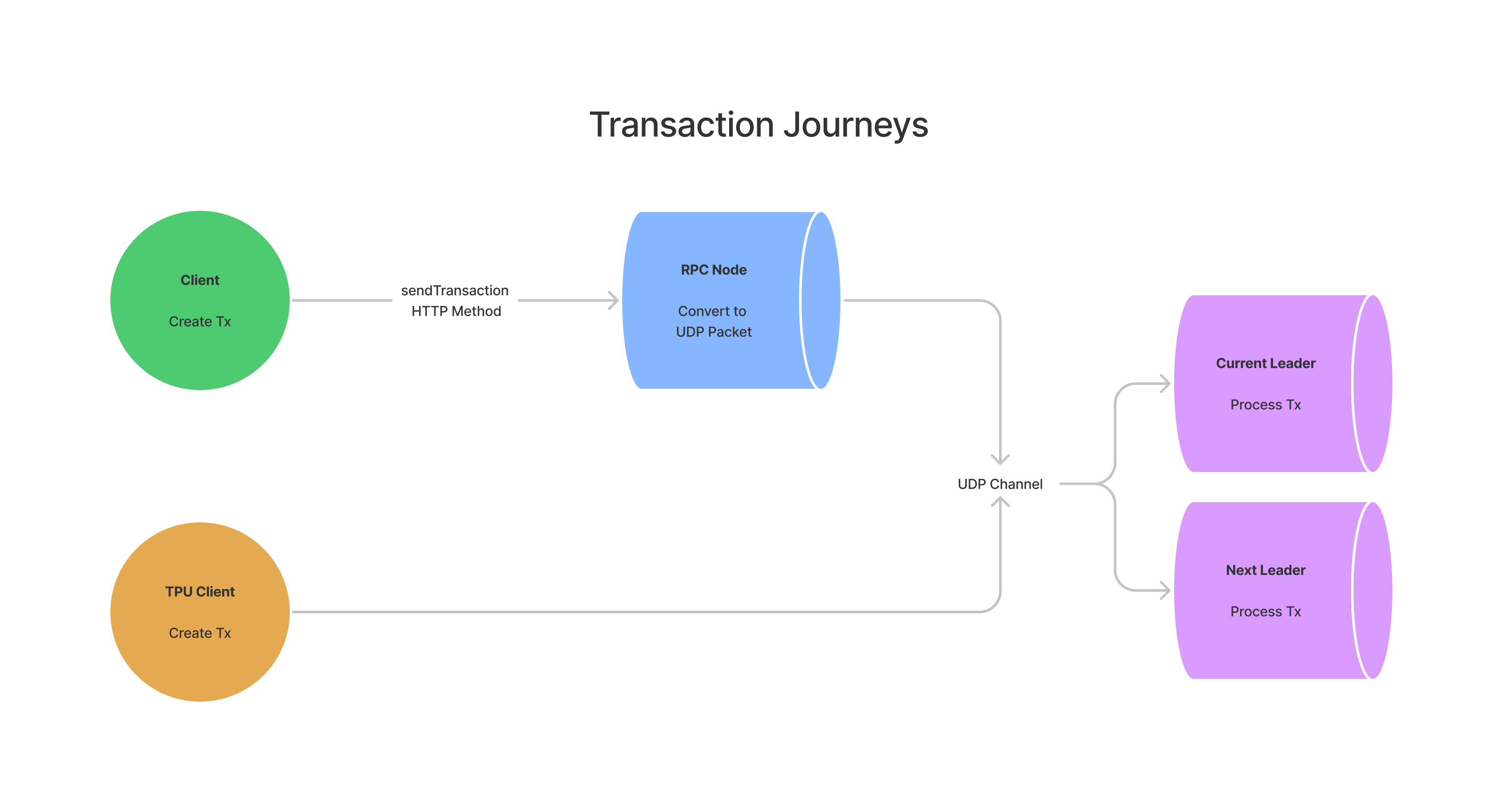 Overview of a transactions journey, from client to leader
Overview of a transactions journey, from client to leader
How RPC Nodes Broadcast Transactions #
After an RPC node receives a transaction via sendTransaction, it will convert
the transaction into a
UDP packet before
forwarding it to the relevant leaders. UDP allows validators to quickly
communicate with one another, but does not provide any guarantees regarding
transaction delivery.
Because Solana's leader schedule is known in advance of every epoch (~2 days), an RPC node will broadcast its transaction directly to the current and next leaders. This is in contrast to other gossip protocols such as Ethereum that propagate transactions randomly and broadly across the entire network. By default, RPC nodes will try to forward transactions to leaders every two seconds until either the transaction is finalized or the transaction's blockhash expires (150 blocks or ~1 minute 19 seconds as of the time of this writing). If the outstanding rebroadcast queue size is greater than 10,000 transactions, newly submitted transactions are dropped. There are command-line arguments that RPC operators can adjust to change the default behavior of this retry logic.
When an RPC node broadcasts a transaction, it will attempt to forward the transaction to a leader's Transaction Processing Unit (TPU). The TPU processes transactions in five distinct phases:
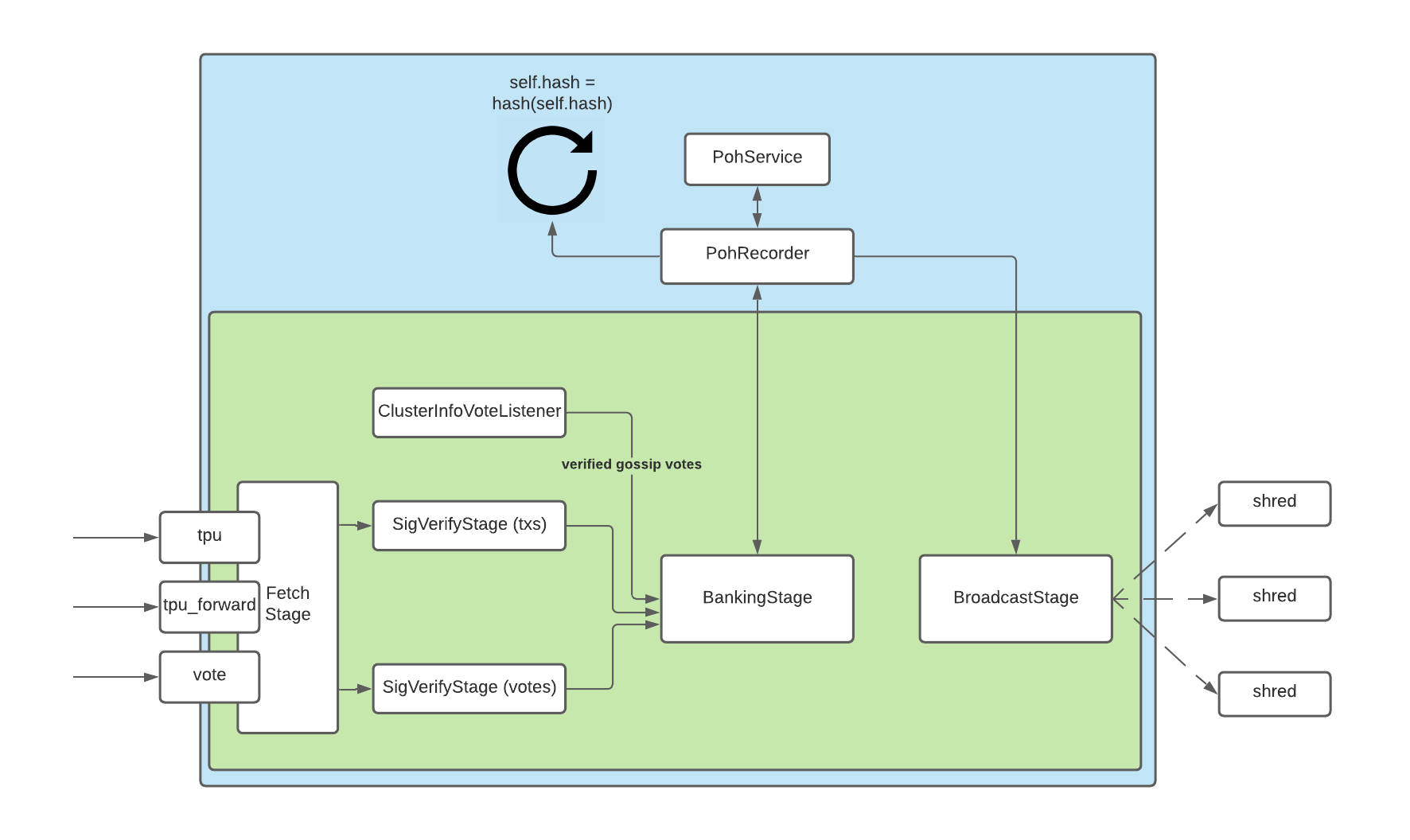 Overview of the Transaction Processing Unit (TPU)
Overview of the Transaction Processing Unit (TPU)
Of these five phases, the Fetch Stage is responsible for receiving transactions. Within the Fetch Stage, validators will categorize incoming transactions according to three ports:
- tpu handles regular transactions such as token transfers, NFT mints, and program instructions
- tpu_vote focuses exclusively on voting transactions
- tpu_forwards forwards unprocessed packets to the next leader if the current leader is unable to process all transactions
For more information on the TPU, please refer to this excellent writeup by Jito Labs.
How Transactions Get Dropped #
Throughout a transaction's journey, there are a few scenarios in which the transaction can be unintentionally dropped from the network.
Before a transaction is processed #
If the network drops a transaction, it will most likely do so before the
transaction is processed by a leader. UDP
packet loss is the simplest reason
why this might occur. During times of intense network load, it's also possible
for validators to become overwhelmed by the sheer number of transactions
required for processing. While validators are equipped to forward surplus
transactions via tpu_forwards, there is a limit to the amount of data that can
be
forwarded.
Furthermore, each forward is limited to a single hop between validators. That
is, transactions received on the tpu_forwards port are not forwarded on to
other validators.
There are also two lesser known reasons why a transaction may be dropped before
it is processed. The first scenario involves transactions that are submitted via
an RPC pool. Occasionally, part of the RPC pool can be sufficiently ahead of the
rest of the pool. This can cause issues when nodes within the pool are required
to work together. In this example, the transaction's
recentBlockhash is queried from
the advanced part of the pool (Backend A). When the transaction is submitted to
the lagging part of the pool (Backend B), the nodes will not recognize the
advanced blockhash and will drop the transaction. This can be detected upon
transaction submission if developers enable
preflight checks on sendTransaction.
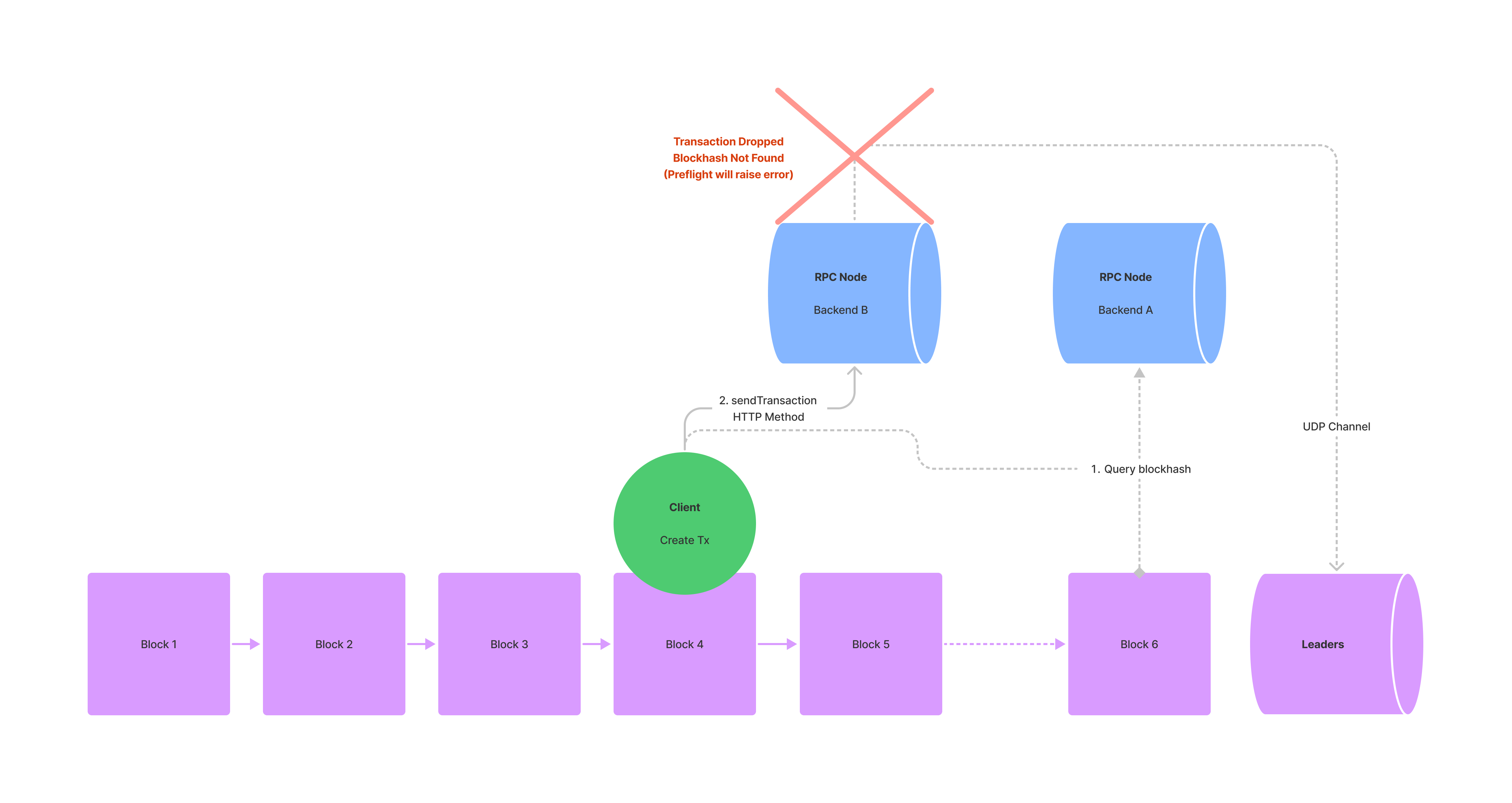 Transaction dropped via an RPC Pool
Transaction dropped via an RPC Pool
Temporary network forks can also result in dropped transactions. If a validator
is slow to replay its blocks within the Banking Stage, it may end up creating a
minority fork. When a client builds a transaction, it's possible for the
transaction to reference a recentBlockhash that only exists on the minority
fork. After the transaction is submitted, the cluster can then switch away from
its minority fork before the transaction is processed. In this scenario, the
transaction is dropped due to the blockhash not being found.
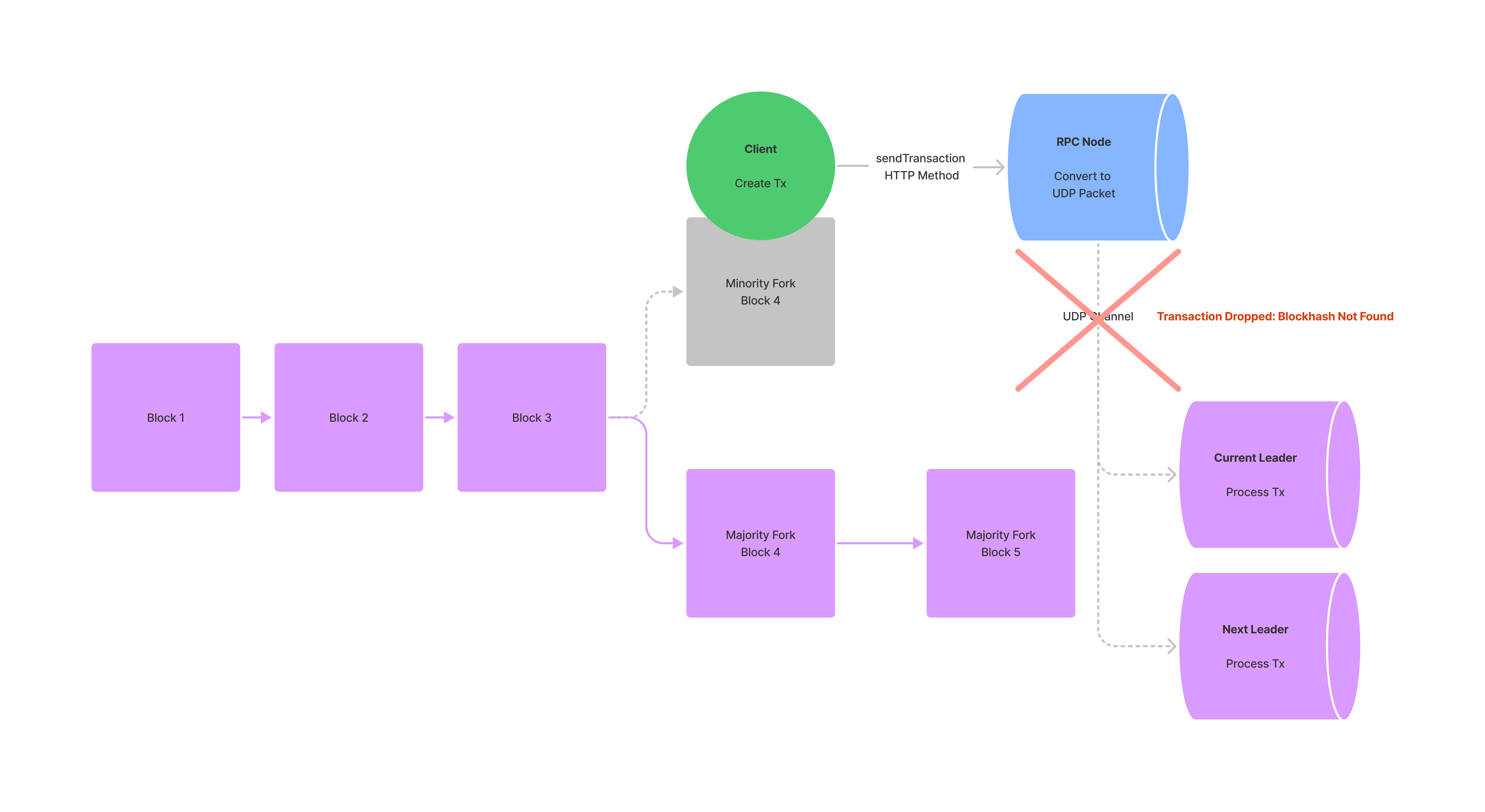 Transaction dropped due to minority fork (before processed)
Transaction dropped due to minority fork (before processed)
After a transaction is processed and before it is finalized #
In the event a transaction references a recentBlockhash from a minority fork,
it's still possible for the transaction to be processed. In this case, however,
it would be processed by the leader on the minority fork. When this leader
attempts to share its processed transactions with the rest of the network, it
would fail to reach consensus with the majority of validators that do not
recognize the minority fork. At this time, the transaction would be dropped
before it could be finalized.
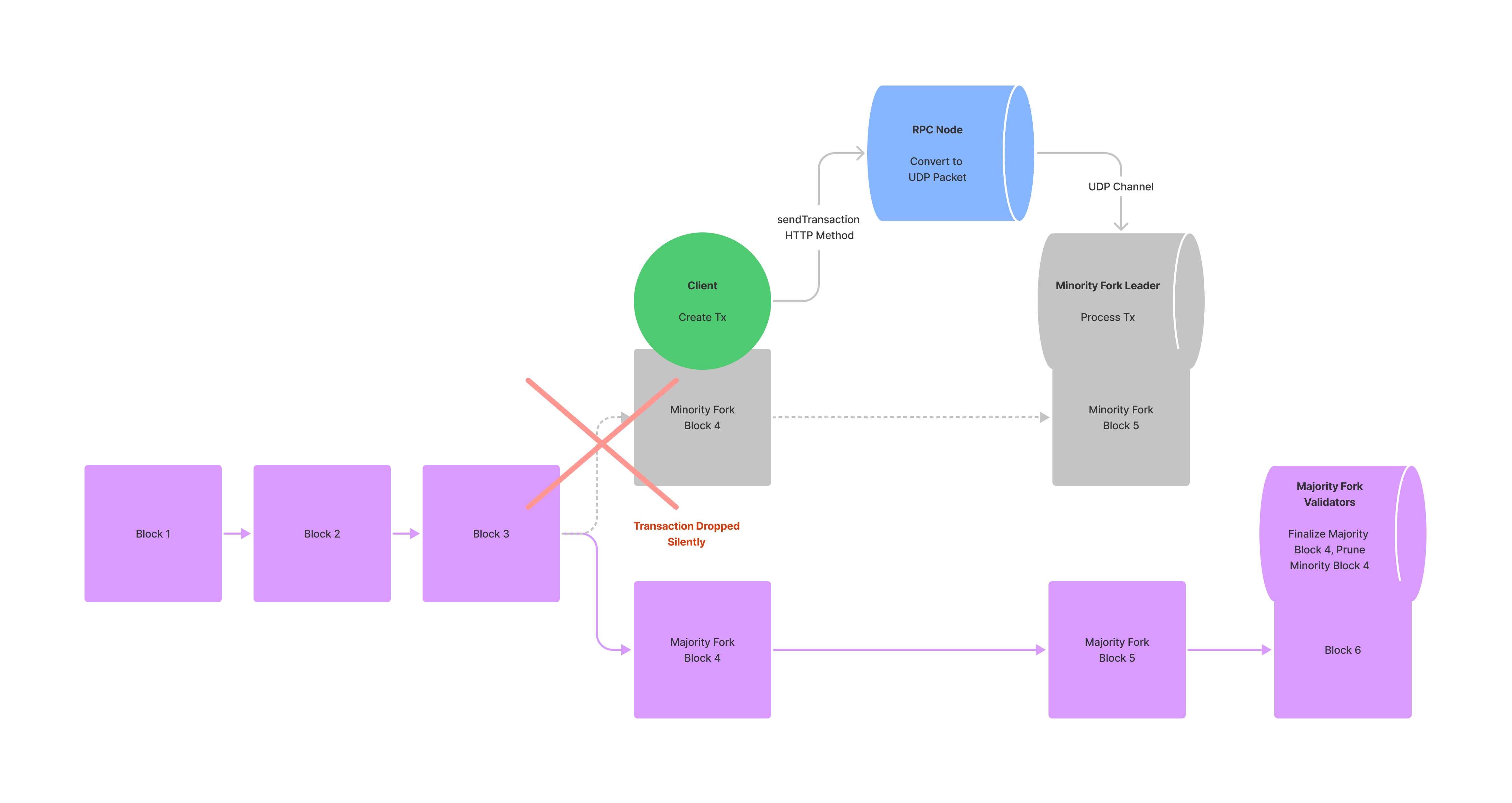 Transaction dropped due to minority fork (after processed)
Transaction dropped due to minority fork (after processed)
Handling Dropped Transactions #
While RPC nodes will attempt to rebroadcast transactions, the algorithm they employ is generic and often ill-suited for the needs of specific applications. To prepare for times of network congestion, application developers should customize their own rebroadcasting logic.
An In-Depth Look at sendTransaction #
When it comes to submitting transactions, the sendTransaction RPC method is
the primary tool available to developers. sendTransaction is only responsible
for relaying a transaction from a client to an RPC node. If the node receives
the transaction, sendTransaction will return the transaction id that can be
used to track the transaction. A successful response does not indicate whether
the transaction will be processed or finalized by the cluster.
Request Parameters #
transaction:string- fully-signed Transaction, as encoded string- (optional)
configuration object:objectskipPreflight:boolean- if true, skip the preflight transaction checks (default: false)- (optional)
preflightCommitment:string- Commitment level to use for preflight simulations against the bank slot (default: "finalized"). - (optional)
encoding:string- Encoding used for the transaction data. Either "base58" (slow), or "base64". (default: "base58"). - (optional)
maxRetries:usize- Maximum number of times for the RPC node to retry sending the transaction to the leader. If this parameter is not provided, the RPC node will retry the transaction until it is finalized or until the blockhash expires.
Response:
transaction id:string- First transaction signature embedded in the transaction, as base-58 encoded string. This transaction id can be used withgetSignatureStatusesto poll for status updates.
Customizing Rebroadcast Logic #
In order to develop their own rebroadcasting logic, developers should take
advantage of sendTransaction's maxRetries parameter. If provided,
maxRetries will override an RPC node's default retry logic, allowing
developers to manually control the retry process
within reasonable bounds.
A common pattern for manually retrying transactions involves temporarily storing
the lastValidBlockHeight that comes from
getLatestBlockhash. Once stashed, an
application can then
poll the cluster's blockheight and manually
retry the transaction at an appropriate interval. In times of network
congestion, it's advantageous to set maxRetries to 0 and manually rebroadcast
via a custom algorithm. While some applications may employ an
exponential backoff
algorithm, others such as Mango opt to
continuously resubmit
transactions at a constant interval until some timeout has occurred.
import {
Keypair,
Connection,
LAMPORTS_PER_SOL,
SystemProgram,
Transaction,
} from "@solana/web3.js";
import * as nacl from "tweetnacl";
const sleep = async (ms: number) => {
return new Promise(r => setTimeout(r, ms));
};
(async () => {
const payer = Keypair.generate();
const toAccount = Keypair.generate().publicKey;
const connection = new Connection("http://127.0.0.1:8899", "confirmed");
const airdropSignature = await connection.requestAirdrop(
payer.publicKey,
LAMPORTS_PER_SOL,
);
await connection.confirmTransaction({ signature: airdropSignature });
const blockhashResponse = await connection.getLatestBlockhash();
const lastValidBlockHeight = blockhashResponse.lastValidBlockHeight - 150;
const transaction = new Transaction({
feePayer: payer.publicKey,
blockhash: blockhashResponse.blockhash,
lastValidBlockHeight: lastValidBlockHeight,
}).add(
SystemProgram.transfer({
fromPubkey: payer.publicKey,
toPubkey: toAccount,
lamports: 1000000,
}),
);
const message = transaction.serializeMessage();
const signature = nacl.sign.detached(message, payer.secretKey);
transaction.addSignature(payer.publicKey, Buffer.from(signature));
const rawTransaction = transaction.serialize();
let blockheight = await connection.getBlockHeight();
while (blockheight < lastValidBlockHeight) {
connection.sendRawTransaction(rawTransaction, {
skipPreflight: true,
});
await sleep(500);
blockheight = await connection.getBlockHeight();
}
})();When polling via getLatestBlockhash, applications should specify their
intended commitment level.
By setting its commitment to confirmed (voted on) or finalized (~30 blocks
after confirmed), an application can avoid polling a blockhash from a minority
fork.
If an application has access to RPC nodes behind a load balancer, it can also
choose to divide its workload amongst specific nodes. RPC nodes that serve
data-intensive requests such as
getProgramAccounts may be
prone to falling behind and can be ill-suited for also forwarding transactions.
For applications that handle time-sensitive transactions, it may be prudent to
have dedicated nodes that only handle sendTransaction.
The Cost of Skipping Preflight #
By default, sendTransaction will perform three preflight checks prior to
submitting a transaction. Specifically, sendTransaction will:
- Verify that all signatures are valid
- Check that the referenced blockhash is within the last 150 blocks
- Simulate the transaction against the bank slot specified by the
preflightCommitment
In the event that any of these three preflight checks fail, sendTransaction
will raise an error prior to submitting the transaction. Preflight checks can
often be the difference between losing a transaction and allowing a client to
gracefully handle an error. To ensure that these common errors are accounted
for, it is recommended that developers keep skipPreflight set to false.
When to Re-Sign Transactions #
Despite all attempts to rebroadcast, there may be times in which a client is required to re-sign a transaction. Before re-signing any transaction, it is very important to ensure that the initial transaction's blockhash has expired. If the initial blockhash is still valid, it is possible for both transactions to be accepted by the network. To an end-user, this would appear as if they unintentionally sent the same transaction twice.
In Solana, a dropped transaction can be safely discarded once the blockhash it
references is older than the lastValidBlockHeight received from
getLatestBlockhash. Developers should keep track of this
lastValidBlockHeight by querying
getEpochInfo and comparing with
blockHeight in the response. Once a blockhash is invalidated, clients may
re-sign with a newly-queried blockhash.